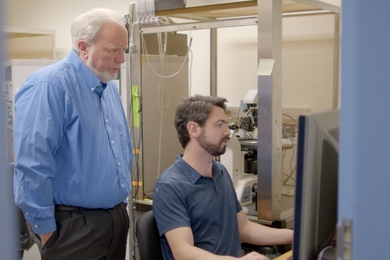MIT Professor Emeritus Keith H. Johnson, a quantum physicist who pioneered the use of theoretical methods in materials science and later applied his expertise to independent filmmaking, died in June in Cambridge, Massachusetts. He was 89.
A professor in MIT’s Department of Materials Science and Engineering (DMSE), Johnson used first principles to understand how electrons behave in materials — that is, he turned to fundamental laws of nature to calculate their behavior, rather than relying solely on experimental data. This approach gave scientists deeper insight into materials before they were made in a lab — helping lay the groundwork for today’s computer-driven methods of materials discovery.
DMSE Professor Harry Tuller, who collaborated with Johnson in the early 1980s, notes that while first-principles calculations are now commonplace, they were unusual at the time.
“Solid-state physicists were largely focused on modeling the electronic structure of materials like semiconductors and metals using extended wave functions,” Tuller says, referring to mathematical descriptions of electron behavior in crystals — a much quicker method. “Keith was among the minority that took a more localized chemical approach.”
That localized approach allowed Johnson to better examine materials with tiny imperfections called defects, such as in zinc oxide. His methods advanced the understanding of materials used in devices like gas sensors and water-splitting systems for hydrogen fuel. It also gave him deeper insight into complex systems such as superconductors — materials that conduct electricity without resistance — and molecular materials like “buckyballs.”
Johnson’s curiosity took creative form in 2001’s “Breaking Symmetry,” a sci-fi thriller he wrote, produced, and directed. Published on YouTube in 2020, it has been viewed more than 4 million times.
Trailblazing theorist at DMSE
Born in Reading, Pennsylvania, in 1936, Johnson showed an early interest in science. “After receiving a chemistry set as a child, he built a laboratory in his parents’ basement,” says his wife, Franziska Amacher-Johnson. “His early experiments were intense — once prompting an evacuation of the house due to chemical fumes.”
He earned his undergraduate degree in physics at Princeton University and his doctorate from Temple University in 1965. He joined the MIT faculty in 1967, in what was then called the Department of Metallurgy and Materials Science, and worked there for nearly 30 years.
His early use of theory in materials science led to more trailblazing. To model the behavior of electrons in small clusters of atoms — such as material surfaces, boundaries between different materials called interfaces, and defects — Johnson used cluster molecular orbital calculations, a quantum mechanical technique that focuses on how electrons behave in tightly grouped atomic structures. These calculations offered insight into how defects and boundaries influence material performance.
“This coupled very nicely with our interests in understanding the roles of bulk defects, interface and surface energy states at grain boundaries and surfaces in metal oxides in impacting their performance in various devices,” Tuller says.
In one project, Johnson and Tuller co-advised a PhD student who conducted both experimental testing of zinc oxide devices and theoretical modeling using Johnson’s methods. At the time, such close collaboration between experimentalists and theorists was rare. Their work led to a “much clearer and advanced understanding of how the nature of defect states formed at interfaces impacted their performance, long before this type of collaboration between experimentalists and theorists became what is now the norm,” Tuller said.
Johnson’s primary computational tool was yet another innovation, called the scattered wave method (also known as Xα multiple scattering). Though the technique has roots in mid-20th century quantum chemistry and condensed matter physics, Johnson was a leading figure in adapting it to materials applications.
Brian Ahern PhD ’84, one of Johnson’s former students, recalls the power of his approach. In 1988, while evaluating whether certain superconducting materials could be used in a next-generation supercomputer for the Department of Defense, Ahern interviewed leading scientists across the country. Most shared optimistic assessments — except Johnson. Drawing on deep theoretical calculations, Johnson showed that the zero-resistance conditions required for such a machine were not realistically achievable with the available materials.
“I reported Johnson’s findings, and the Pentagon program was abandoned, saving millions of dollars,” Ahern says.
From superconductors to screenplays
Johnson remained captivated by superconductors. These materials can conduct electricity without energy loss, making them crucial to technologies such as MRI machines and quantum computers. But they typically operate at cryogenic temperatures, requiring costly equipment. When scientists discovered so-called high-temperature superconductors — materials that worked at comparatively warmer, but still very cold (-300 degrees Fahrenheit), temperatures — a global race kicked off to understand their behavior and look for superconductors that could function at room temperature.
Using the theoretical tools he had earlier developed, Johnson proposed that vibrations of small molecular units were responsible for superconductivity — a departure from conventional thinking about what caused superconductivity. In a 1992 paper, he showed that the model could apply to a range of materials, including ceramics and buckminsterfullerene, nicknamed buckyballs because its molecules resemble architect Buckminster Fuller’s geodesic domes. Johnson predicted that room-temperature superconductivity was unlikely, because the materials needed to support it would be too unstable to work reliably.
That didn’t stop him from imagining scientific breakthroughs in fiction. A consulting trip to Russia after the fall of the Soviet Union sparked Johnson’s interest in screenwriting. Among his screenplays was “Breaking Symmetry,” about a young astrophysicist at a fictionalized MIT who discovers secret research on a radical new energy technology. When a Hollywood production deal fell through, Johnson decided to fund and direct the film himself — and even created its special effects.
Even after his early retirement from MIT, in 1996, Johnson continued to pursue research. In 2021, he published a paper on water nanoclusters in space and their possible role in the origins of life, suggesting that their properties could help explain cosmic phenomena. He also used his analytical tools to propose visual, water-based models for dark matter and dark energy — what he called “quintessential water.”
In his later years, Johnson became increasingly interested in presenting scientific ideas through images and intuition rather than dense equations, believing that nature should be understandable without complex mathematics, Amacher-Johnson says. He embraced multimedia and emerging digital tools — including artificial intelligence — to share his ideas. Several of his presentations can be found on his YouTube channel.
“He never confined himself to a single field,” Amacher-Johnson explains. “Physics, chemistry, biology, cosmology — all were part of his unified vision of understanding the universe.”
In addition to Amacher-Johnson, Johnson is survived by his daughter.







